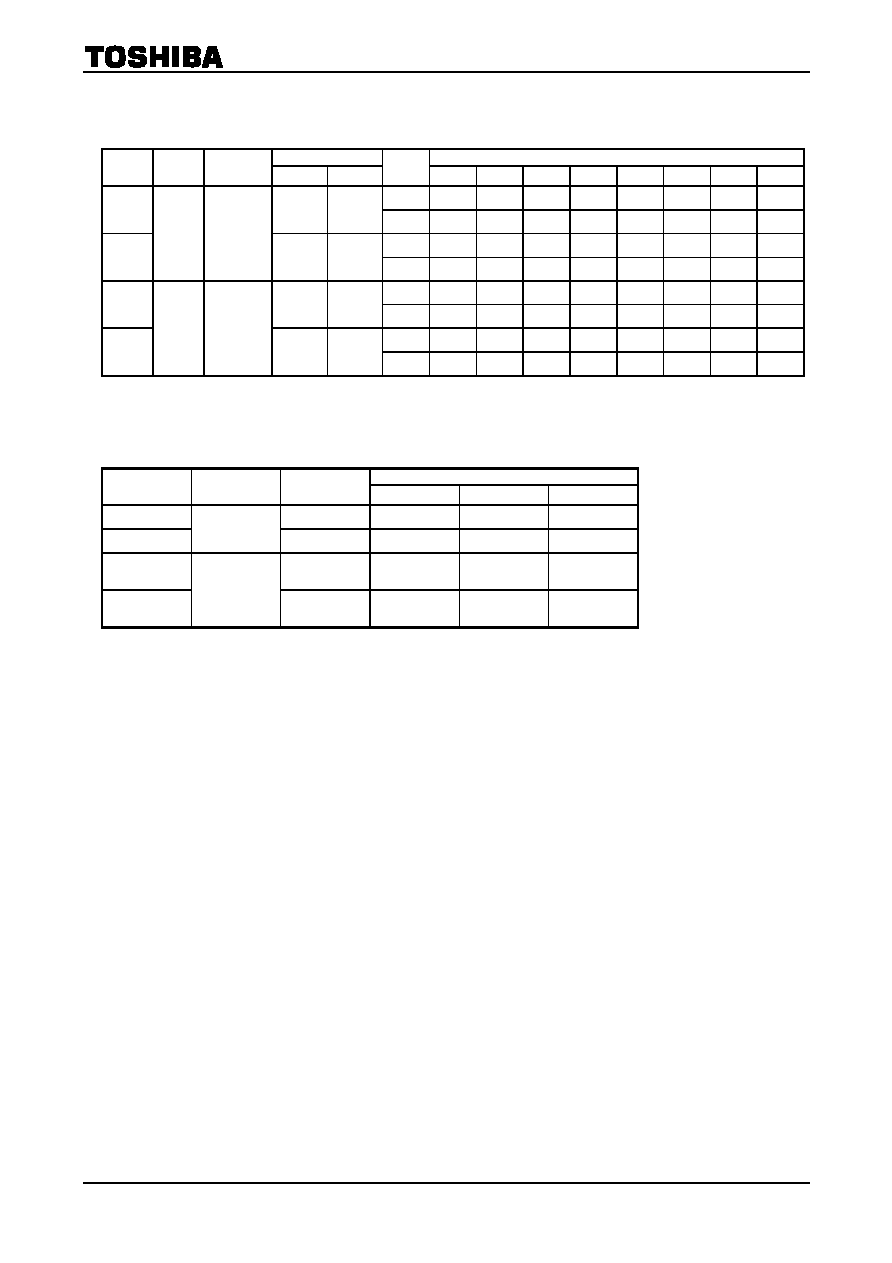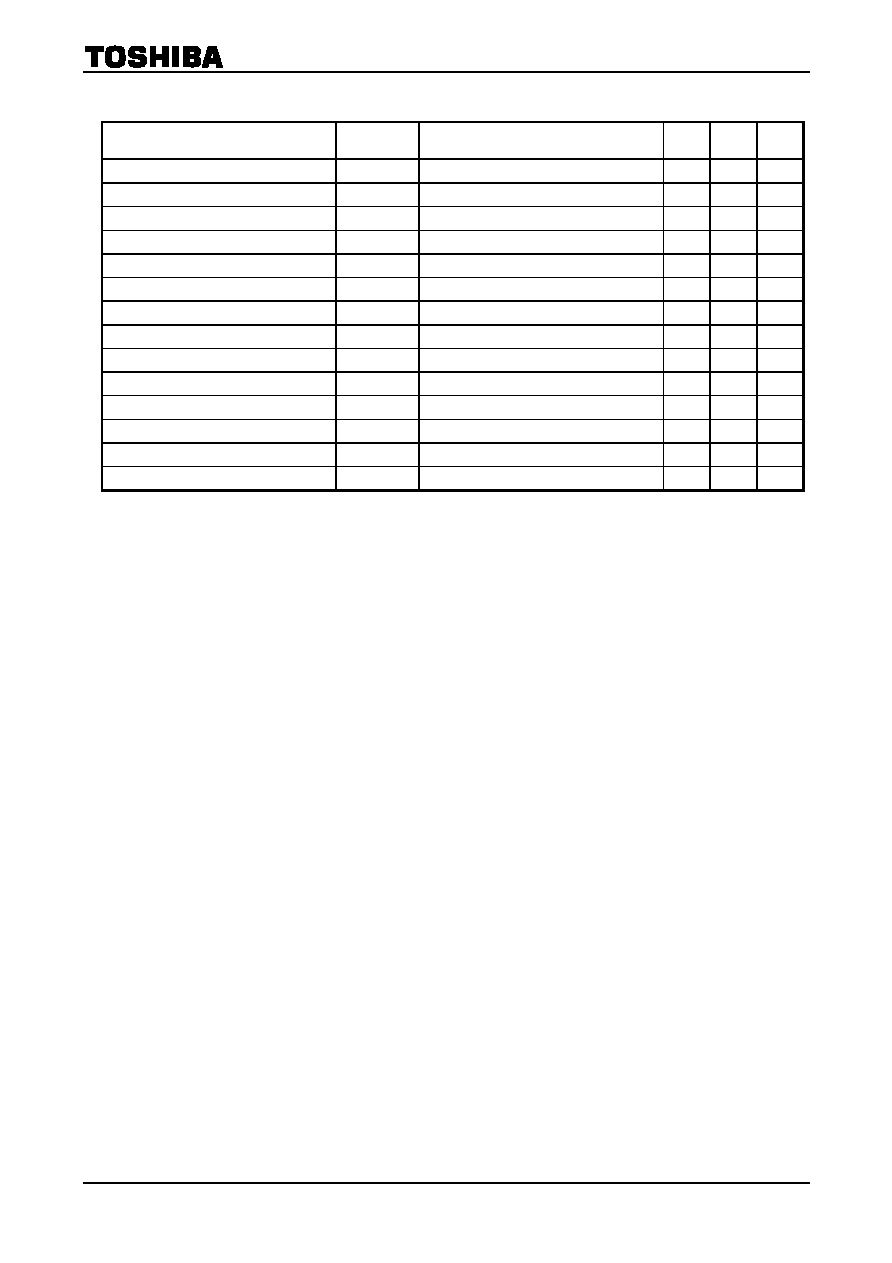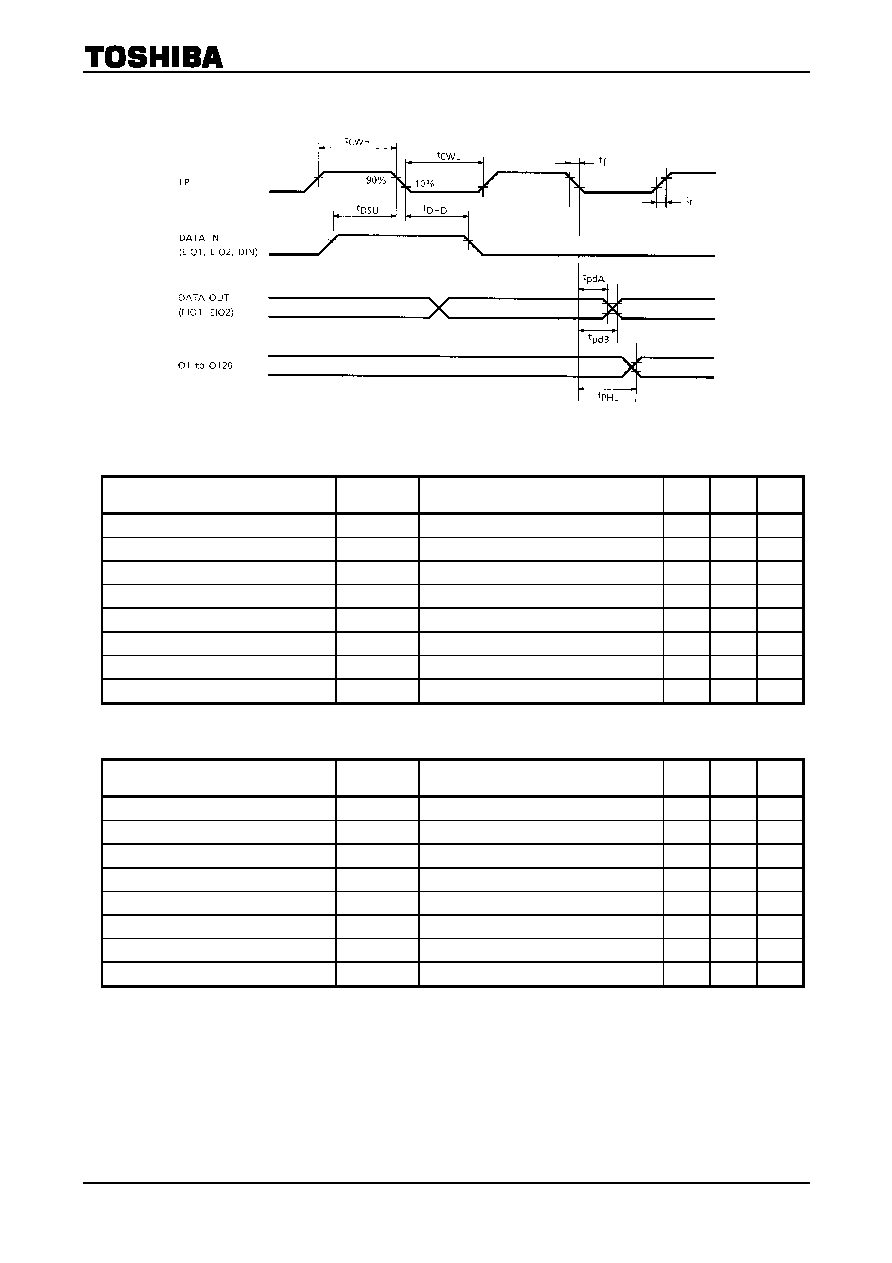
T6C03
2001-02-13 1/12
TOSHIBA CMOS DIGITAL INTEGRATED CIRCUIT SILICON MONOLITHIC
T6C03
COLUMN AND ROW DRIVER FOR A DOT MATRIX LCD
The T6C03 is a 160-channel-output column and row driver for
an STN dot matrix LCD.
The T6C03 features a 42-V LCD drive voltage and an 8-MHz
maximum operating frequency. The T6C03 is able to drive LCD
panels with a duty ratio of up to 1 / 480.
Features
l Display duty application
: to 1 / 480
l LCD drive signal
: 160
l Data transfer
: Column: 4 / 8-bit bidirectional
Row: Single / Dual bidirectional
l Operating frequency
: 8 MHz (V
DD
= 5 V ± 10%)
l LCD drive voltage
: 14 to 42 V
l Power supply voltage
: 2.7 to 5.5 V
l Operating temperature
: -20 to 75∞C
l LCD drive output resistance : 1.3 k (max) (20 V, 1 / 13 bias)
l Display-off function
: When / DSPOF is L, all LCD drive outputs (O1 to O160) remain at the V5 level.
l Low power consumption
: Cascade connection and auto enable transfer functions are available.
l EI / LP input
: EI / LP input enables LSI operation.
Connect EIO1 / 2 from the 1st LSI to L.
∑ TOSHIBA is continually working to improve the quality and reliability of its products. Nevertheless, semiconductor devices in general
can malfunction or fail due to their inherent electrical sensitivity and vulnerability to physical stress. It is the responsibility of the
buyer, when utilizing TOSHIBA products, to comply with the standards of safety in making a safe design for the entire system, and
to avoid situations in which a malfunction or failure of such TOSHIBA products could cause loss of human life, bodily injury or
damage to property.
In developing your designs, please ensure that TOSHIBA products are used within specified operating ranges as set forth in the
most recent TOSHIBA products specifications. Also, please keep in mind the precautions and conditions set forth in the "Handling
Guide for Semiconductor Devices," or "TOSHIBA Semiconductor Reliability Handbook" etc..
∑ The TOSHIBA products listed in this document are intended for usage in general electronics applications (computer, personal
equipment, office equipment, measuring equipment, industrial robotics, domestic appliances, etc.). These TOSHIBA products are
neither intended nor warranted for usage in equipment that requires extraordinarily high quality and/or reliability or a malfunction or
failure of which may cause loss of human life or bodily injury ("Unintended Usage"). Unintended Usage include atomic energy
control instruments, airplane or spaceship instruments, transportation instruments, traffic signal instruments, combustion control
instruments, medical instruments, all types of safety devices, etc.. Unintended Usage of TOSHIBA products listed in this document
shall be made at the customer's own risk.
∑ Polyimide base film is hard and thin. Be careful not to injure yourself on the film or to scratch any other parts with the film. Try to
design and manufacture products so that there is no chance of users touching the film after assembly, or if they do , that there is no
chance of them injuring themselves. When cutting out the film, try to ensure that the film shavings do not cause accidents. After use,
treat the leftover film and reel spacers as industrial waste.
∑ Light striking a semiconductor device generates electromotive force due to photoelectric effects. In some cases this can cause the
device to malfunction.
This is especially true for devices in which the surface (back), or side of the chip is exposed. When designing circuits, make sure
that devices are protected against incident light from external sources. Exposure to light both during regular operation and during
inspection must be taken into account.
∑ The products described in this document are subject to the foreign exchange and foreign trade laws.
∑ The information contained herein is presented only as a guide for the applications of our products. No responsibility is assumed by
TOSHIBA CORPORATION for any infringements of intellectual property or other rights of the third parties which may result from its
use. No license is granted by implication or otherwise under any intellectual property or other rights of TOSHIBA CORPORATION or
others.
∑ The information contained herein is subject to change without notice.
000707EBE1

T6C03
2001-02-13 4/12
Pin Functions
Pin Name
I / O
Functions
Level
O1 to O160
Output
Output for LCD drive signal
V
0
to V
5
(Column mode)
Input / output for enable signal
DIR selects In or Out.
Connect EIO (IN) of 1st LSI to L.
For a cascade connection, connect EIO (OUT) to EIO (IN) of next LSI.
EIO1, EIO2
I / O
(Row mode)
Input / output for shift data
DIR = L : EIO1 is output, EIO2 is input
DIR = H : EIO1 is input, EIO2 is output
(Column mode)
Input for data signal
DI1 to DI8
Input
(Row mode)
DI1 to DI7: Fix to H or L, DI8: when DF = H, use as DIN
DIR Input
(Direction)
Input for data flow direction select
/ DSPOF
Input
(Display off)
/ DSPOF = L : Display-off mode, (O1 to O160) remain at the V
5
level
/ DSPOF = H : Display-on mode, (O1 to O160) are operational.
DF Input
(Data format)
Input for data bit select
(Latch pulse)
Display data is latched on falling edges of LP.
When EIO (IN) = L,
SCP
∑ LP = H enables the 1st LSI.
LP Input
(Row mode)
Input for shift clock pulse
FR Input
(Frame)
Input for frame signal
(Column mode)
Input for shift clock pulse
SCP Input
(Row mode)
Fix to H or L
TEST Input
(TEST)
Fix to L
S / C
Input
Input for mode select: H = Column mode, L = Row mode
V
DD
to V
SS

T6C03
2001-02-13 9/12
Absolute Maximum Ratings
(Ensure that the following conditions are maintained, V
CC
V
0
V
2
V
3
V
5
V
SS
)
Item Symbol
Pin
Name
Rating
Unit
Supply Voltage (1)
V
DD
V
DD
-0.3 to 7.0
V
Supply Voltage (2)
V
CC
V
CCL / R
-0.3 to 45.0
V
Supply Voltage (3)
V
0
, V
2
V
0L / R
V
2L / R
-0.3 to V
CC
+ 0.3
V
Supply Voltage (4)
V
3
, V
5
V
3L / R
V
5L / R
-0.3 to 7.0
V
Input Voltage
V
IN
(Note
2) -0.3 to V
DD
+ 0.3
V
Operating Temperature
T
opr
-20 to 75
∞C
Storage Temperature
T
stg
-40 to 125
∞C
Note 2: SCP, FR, LP, DIR, DF, S / C, EIO1, EIO2, DI1 to 8, / DSPOF, TEST
Electrical Characteristics
DC Characteristics
(Unless otherwise noted, V
SS
= 0 V, V
DD
= 2.7 to 5.5 V, Ta = -20 to 75∞C)
Item Symbol
Test
Circuit
Test Condition
Min
Typ.
Max
Unit
Pin Name
Supply Voltage 1
V
DD
2.7
5.0
5.5
V
DD
Supply Voltage 2
V
CC
14
42
V
CCL
/ R
H Level
V
IH
0.8
V
DD
V
DD
Input
Voltage
L Level
V
IL
(Note 2)
0
0.2
V
DD
SCP, FR, LP,
DIR, DF, S / C,
EIO1, EIO2,
DI1 to 8,
/ DSPOF,
TEST
H Level
V
OH
I
OH
= - 0.5 mA
V
DD
- 0.5
V
DD
Output
Voltage
L Level
V
OL
I
OL
= 0.5 mA
0
0.5
V
EIO1, EIO2
H Level
R
OH
V
OUT
= V
0
- 0.5 V
(Note 3)
0.6 1.3
V
OUT
= V
2
± 0.5 V
(Note 3)
0.6 1.3
M Level
R
OM
V
OUT
= V
3
± 0.5 V
(Note 3)
0.6 1.3
Output
Resistance
L Level
R
OL
V
OUT
= V
5
+ 0.5 V
(Note 3)
0.6 1.3
k O1
to
O160
Current
Consumption (Note 4)
I
DD
V
DD
= 5.5 V
V
CC
= 42 V
f
LP
= 33 kHz
f
FR
= 8.3 kHz
f
scp
= 8.0 MHz
Input Data: every bit inverted
V
IH
= 5.5 V, V
IL
= 0 V
4.0 mA
V
DD
Note 3: V
CC
= 20 V, 1 / 13 bias
Note 4: Current consumption while the internal data receiver is operating











